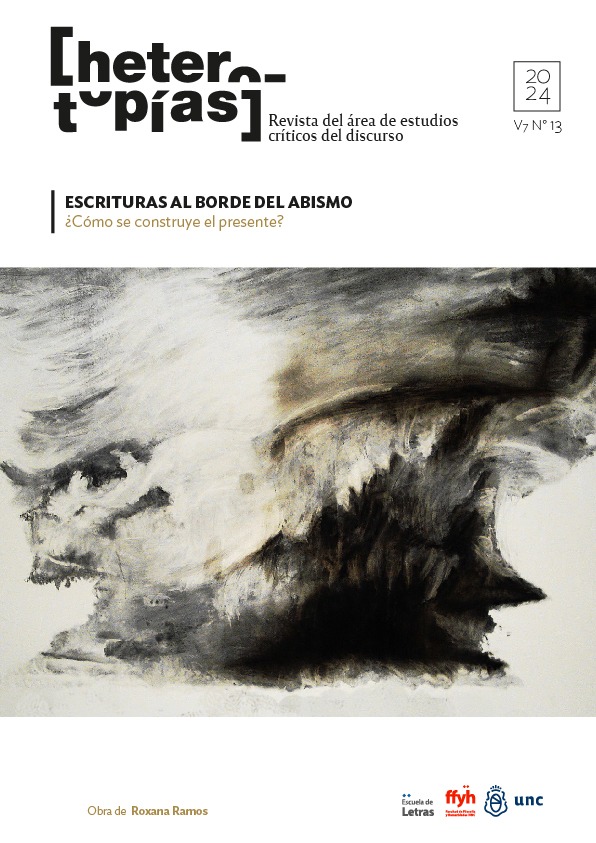“Fire in the Archive”. Amerindian practices, knowledges and repertoires in Contemporary Latin American Culture
Main Article Content
Abstract
During the first decades of the 21st century, Amerindian practices, knowledge, imaginaries, and repertoires gained unprecedented visibility. Works and installations by Amerindian artists are featured in art biennials, and texts by Amerindian writers and intellectuals win prestigious awards for the first time in history. In this paper, I analyze some Amerindian practices and repertoires to interrogate how they pluralize the pasts of Latin American culture, and their legacies, but also, I would like to suggest, the forms, materials, and repertoires of what we understand today as contemporary art and writing in Latin America.
Downloads
Article Details

This work is licensed under a Creative Commons Attribution-NonCommercial-ShareAlike 4.0 International License.
Those authors who have publications with this journal, accept the following terms: Those authors who have publications with this journal, accept the following terms:
a. The authors will keep their copyright and guarantee to the journal the right of first publication of their work, which will be simultaneously subject to the Creative Commons Attribution - Non-Commercial - Share Alike (by-nc-sa) Attribution License; no commercial use of the original work or any derivative works is allowed, the distribution of which must be done with a license equal to the one that regulates the original work.
b. Authors may adopt other non-exclusive license agreements for the distribution of the published version of the work (e.g., deposit it in an institutional telematic archive or publish it in a monographic volume) provided that the initial publication in this journal is indicated.
c. Authors are allowed and recommended to disseminate their work through the Internet (e.g. in institutional telematic archives or on their website) before and during the submission process, which may lead to interesting exchanges and increase the number of citations of the published work. (See The effect of open access).
How to Cite
References
Albert, B. (2002). O ouro canibal e a queda do céu: Uma crítica xamânica da economia política da natureza (Yanomami) En Pacificando o branco: Cosmologias do contato no norte-Amazonico [en línea]. Marseille: IRD Éditions (generado el 04 février 2024). Recuperado de: https://doi.org/10.4000/books.irdeditions.24767
Buono, A. (2018). Seu tesouro são penas de pássaro: arte plumária tupinambá e a imagem da América. Figura: Studies on the Classical Tradition, 6 (2), jul-dez, 13-29.
Cadahia, L. y Coronel, V. (2021). Volver al archivo. De las fantasías decoloniales a la imaginación republicana. En Marey, M. (ed.), Teorías de la República y prácticas republicanas. Barcelona: Herder.
Cadena, M. y Starn, O. (2009). Indigeneidad: problemáticas, experiencias y agendas en el nuevo milenio. Tabula Rasa, 10, enero-junio, 191-223. Universidad Colegio Mayor de Cundinamarca Bogotá.
Cadena, M. y Starn, O. (2007). Indigenous Experience Today. New York: Roultedge,
Calfuqueo Aliste, S. Statement. Recuperado de: https://sebacalfuqueo.com/statement/ último acceso 24/06/2024
Clifford, J. (2013). Returns. Becoming Indigenous in the Twenty-First Century. Cambridge: Harvard University Press.
Chapman, A. (2007). Fin de un mundo. Los selknam de Tierra del Fuego. Buenos Aires: Emecé.
Danowski, D. y Viveiros de Castro, E. (2014). Há mundo porvir? Ensaio sobre os medos e os fins. Florianópolis: Desterro, Cultura e Barbárie e Instituto Socioambiental.
Esbell, J. (2021). O que são 70 anos diante de 521, meu querido?. Entrevista por Artur Tavares. Elástica, 3 de octubre. Recuperado de: https://elastica.abril.com.br/especiais/jaider-esbell-bienal-mam, último acceso 21/03/2023.
Esbell, J. (2021) Moquém_Surarî: Arte Indígena Contemporânea. Recuperado de: https://mam.org.br/exposicao/moquem_surari-arte-indigena-contemporanea, último acceso 21/03/2023
Esbell, J. (2023). Jaider Esbell. Tembetá. Azougue Editorial.
Francica, C. (2023) Feminisms. En Andermann, J., Giorgi, G y Saramago, V., Handbook of Latin American Environmental Aesthetics. Berlín, De Gruyter.
Garcia, E. (2020). Signs of the Americas. A Poetics of Pictography, Hieroglyphs, and Khipu. Chicago: The University of Chicago Press.
Ghigliotto, G. (2019). El museo de la bruma. Santiago de Chile: Laurel.
Giorgi, G. (2022). Desorden del tiempo en el museo colonial. Revista Crítica de literatura argentina El matadero, 16, 26-38.
Groys, B. (2009). The Topology of Contemporary Art. En Smith, T et al., Antinomies of Art and Culture. Modernity, Postmodernity, Contemporaneity. Durham: Duke University Press,
Krenak, A. (2023). Futuro ancestral. São Paulo: Companhia das Letras.
Majluf, N. (2022) La invención del indio: Francisco Laso y la imagen del Perú moderno. Instituto de Estudios Peruanos.
Mbembé, A. (2002) The Power of the Archive and its Limits. In: Hamilton, C., Harris, V., Taylor, J., Pickover, M., Reid, G., Saleh, R. (eds) Refiguring the Archive. Springer, Dordrecht. Recuperado de: https://doi.org/10.1007/978-94-010-0570-8_2,
Murphy Turner, M. (2022). Jaider Esbell: Fissures between Worlds. Recuperado de: https://post.moma.org/jaider-esbell-fissures-between-worlds/
Pape, L. y De Moraes, A. (2021). Manto Tupinambá: Memories. Lygia Pape in conversation with Angélica de Moraes. Recuperado de: https://www.hauserwirth.com/ursula/34929-manto-tupinamba-memories-lygia-pape/
Pedrosa, A. (2024). En 60ª Exposición internacional de Arte, La Biennale di Venecia. Recuperado de: https://universes.art/es/bienal-venecia/2024, último acceso 21/03/2024
Pratt, M. L. (2022). Planetary Longings. Durham: Duke University Press.
Librandi-Rocha, M. (2022). Jaider Esbell, Makunaimã Manifesto e a Cosmopolitica da Arte Indígena Contemporânea. En Modernismos 1922-2022. Organized by Gênese Andrade. São Paulo: Companhia das Letras.
Rappaport, J. y Cummins, T. (2011). Beyond the Lettered City. Indigenous literacies in the Andes. Durham: Duke University Press,
Sá, L. (2012). Literaturas da Floresta. Literaturas da floresta: textos amazônicos e cultura latino-americana (M. I. França, Trans.). Rio de Janeiro: EdUERJ.
Vicuña, C. y Livon-Grossman, E (eds.). (2009). Oxford Book of Latin American Poetry. Oxford: Oxford University Press.
Vargas Paillahueque, C. (2020). Ko konümpakey tañi weychan (el agua rememora sus luchas). Sobre ko ñi weychan, de Sebastián Calfuqueo. Artishock Revista, 20 de noviembre. Recuperado de: https://artishockrevista.com/2020/11/28/ko-ni-weychan-sebastian-calfuqueo/ último acceso: 31/1/2024.
Wapichana Caboco, G. y Manoki, T. (2023). Isso tudo não me diz nada. A Impermanência como ponto do encontro no arquivo histórico da Bienal de São Paulo. São Paulo: Fundação Bienal de São Paulo.
